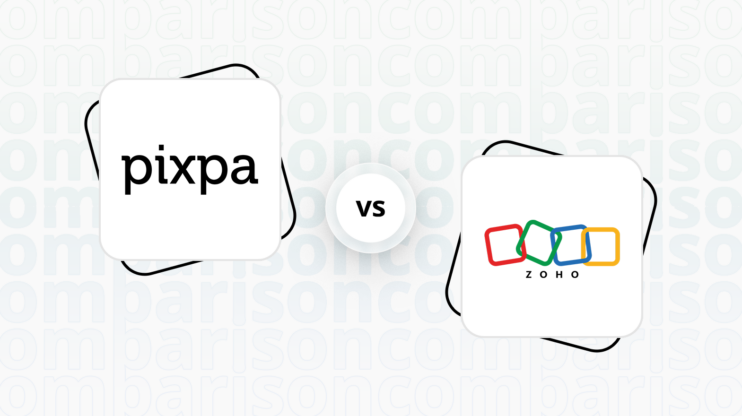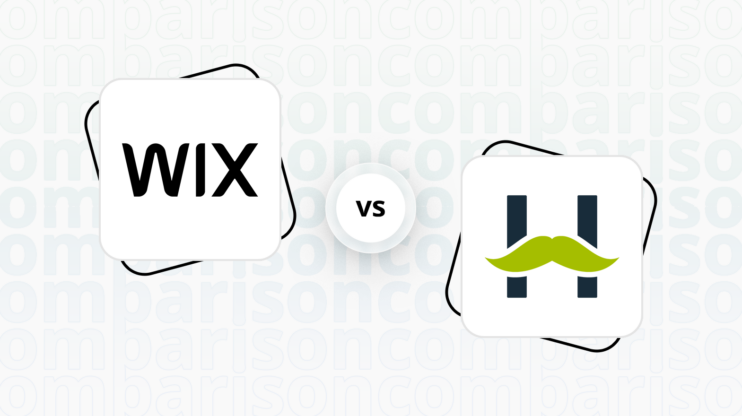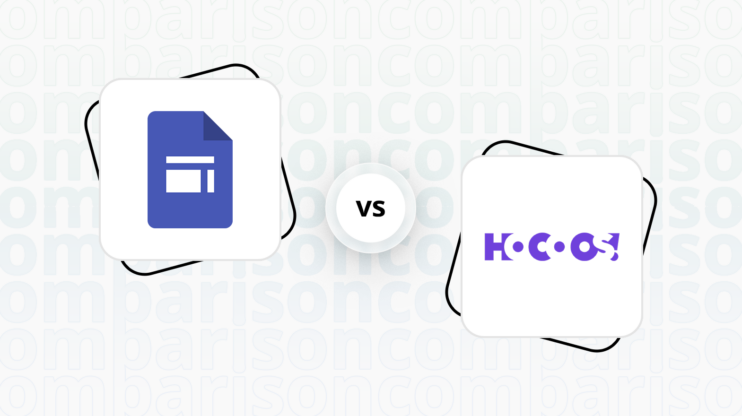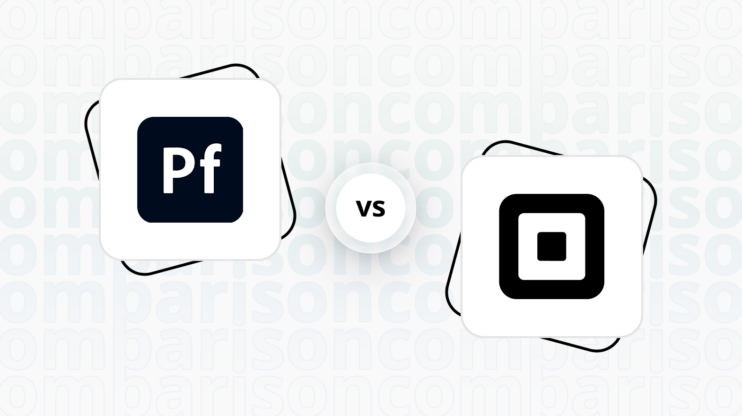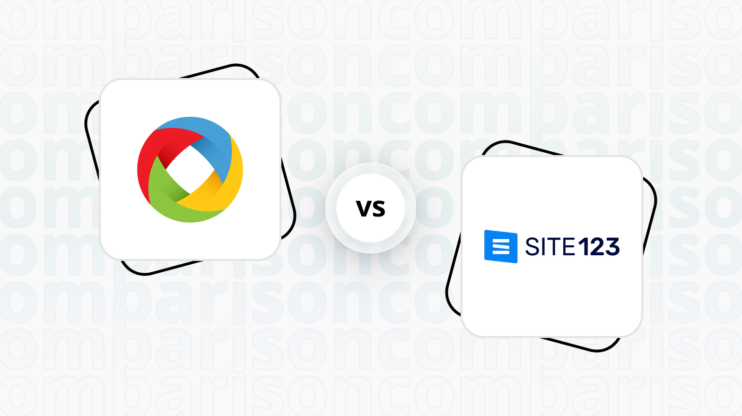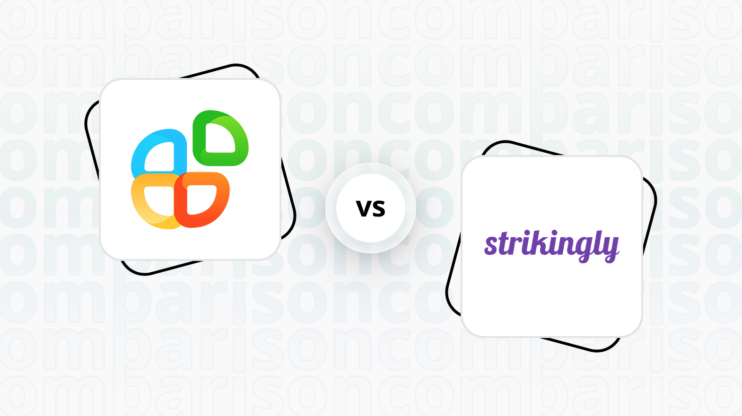Final verdict
Webflow and SubHub cater to different audiences with distinct needs, making each platform uniquely suited for specific types of users.
-
Webflow (Overall Grade: 7.9/10)
is a powerful tool for professional designers and developers looking to create highly customizable, responsive websites without extensive coding. It excels in design functionalities, offering a wide range of templates and robust customization options. Webflow’s comprehensive marketing tools, superior hosting quality, and strong security features make it a top choice for users seeking a versatile and scalable website builder. However, its steeper learning curve may be a challenge for beginners. -
SubHub (Overall Grade: 5.6/10)
is tailored for content creators and entrepreneurs aiming to build and manage membership sites. It offers a user-friendly platform with specific tools for setting up subscription models and managing member access. SubHub’s ease of use and focus on customer support make it ideal for those looking to monetize their content without needing advanced technical skills. However, it falls short in design flexibility, ecommerce capabilities, and overall feature set compared to Webflow.

|

|
|
|---|---|---|
|
Design functionalities & templates |
8.6 |
6.8 |
|
Ease of use |
7.5 |
7.7 |
|
Ecommerce |
8.5 |
5.9 |
|
Website editors |
9.0 |
6.9 |
|
Product testing options |
6.3 |
7.0 |
|
Price |
8.0 |
6.8 |
|
Hosting quality |
8.9 |
5.5 |
|
Website speed optimization |
8.1 |
5.6 |
|
Plugins/extensions and integrations |
5.5 |
5.7 |
|
Marketing features |
7.8 |
5.7 |
|
Customer support |
8.3 |
6.3 |
|
Website security |
7.8 |
4.0 |
|
AI capabilities |
8.3 |
0 |
|
User management |
8.3 |
5.2 |
Best for ecommerce
 8.5
8.5
 5.9
5.9
Verdict
: Webflow is the superior choice for ecommerce due to its comprehensive features and flexibility, while SubHub is more suited for membership-based businesses.
-
Webflow
: Webflow excels in ecommerce with its powerful design tools, extensive customization options, and robust ecommerce features. It supports a wide range of payment gateways, automated shipping calculations, and advanced marketing tools. When comparing Webflow vs SubHub, Webflow stands out for its ability to create highly customized and responsive online stores without requiring extensive coding knowledge. -
SubHub
: SubHub is designed for content creators and entrepreneurs looking to build and monetize membership sites. While it offers basic ecommerce features like PayPal and Stripe integration, it lacks the depth and flexibility of Webflow’s ecommerce capabilities. SubHub is ideal for those focused on creating a community and providing exclusive content, rather than running a traditional online store.
Best for informational & business websites
 8.6
8.6
 7.2
7.2
Verdict
: Webflow is the superior choice for creating visually stunning and highly customizable informational websites, while SubHub is more tailored for membership-based sites with a focus on ease of use.
-
Webflow
: Webflow excels in providing a robust design experience with a wide array of templates and customization options. Its powerful design tools and flexible CMS make it ideal for professional designers and businesses looking to create custom, responsive websites. With a score of 8.6, Webflow stands out for its comprehensive design functionalities and top-tier hosting services, making it a strong contender for informational and business websites. -
SubHub
: SubHub, scoring 7.2, is designed specifically for creating and managing membership sites. It offers a user-friendly platform with tools tailored for content creators and entrepreneurs. While it may not offer the same level of design flexibility as Webflow, SubHub simplifies the process of setting up subscription models and managing member access, making it an excellent choice for those looking to build a community and monetize their content. When comparing Webflow vs SubHub, SubHub’s ease of use and efficiency are its standout features.
Detailed comparison
Design functionalities & templates
Design FunctionalitiesRepresents how well each platform allows for creative design and customization of websites.Score Components:
- Template Variety (30%): Range and quality of design templates.
- Customization (30%): Flexibility and options for design alterations.
- User Interface (20%): Ease and intuitiveness of the design process.
- Responsiveness (10%): Adaptability to different devices and screen sizes.
- Innovation (10%): Unique design features and tools.
 8.6
8.6
 6.8
6.8
🏆
Winner: Webflow.
If you’re looking for a platform that offers more robust design features and a wider variety of templates, Webflow is the preferred choice.
Webflow delivers a robust design experience with a diverse range of template and customization options. Boasting over 1000 pre-built templates covering various industries and website types, including free and premium options, Webflow ensures a constantly evolving library for users. Templates are categorized for easy browsing, considering industry, website type, style, and features. The design customization features include a visual drag-and-drop editor for real-time adjustments, fine-grained control over every aspect of the design, and the ability to inject custom code for advanced users seeking additional personalization and unique functionalities.
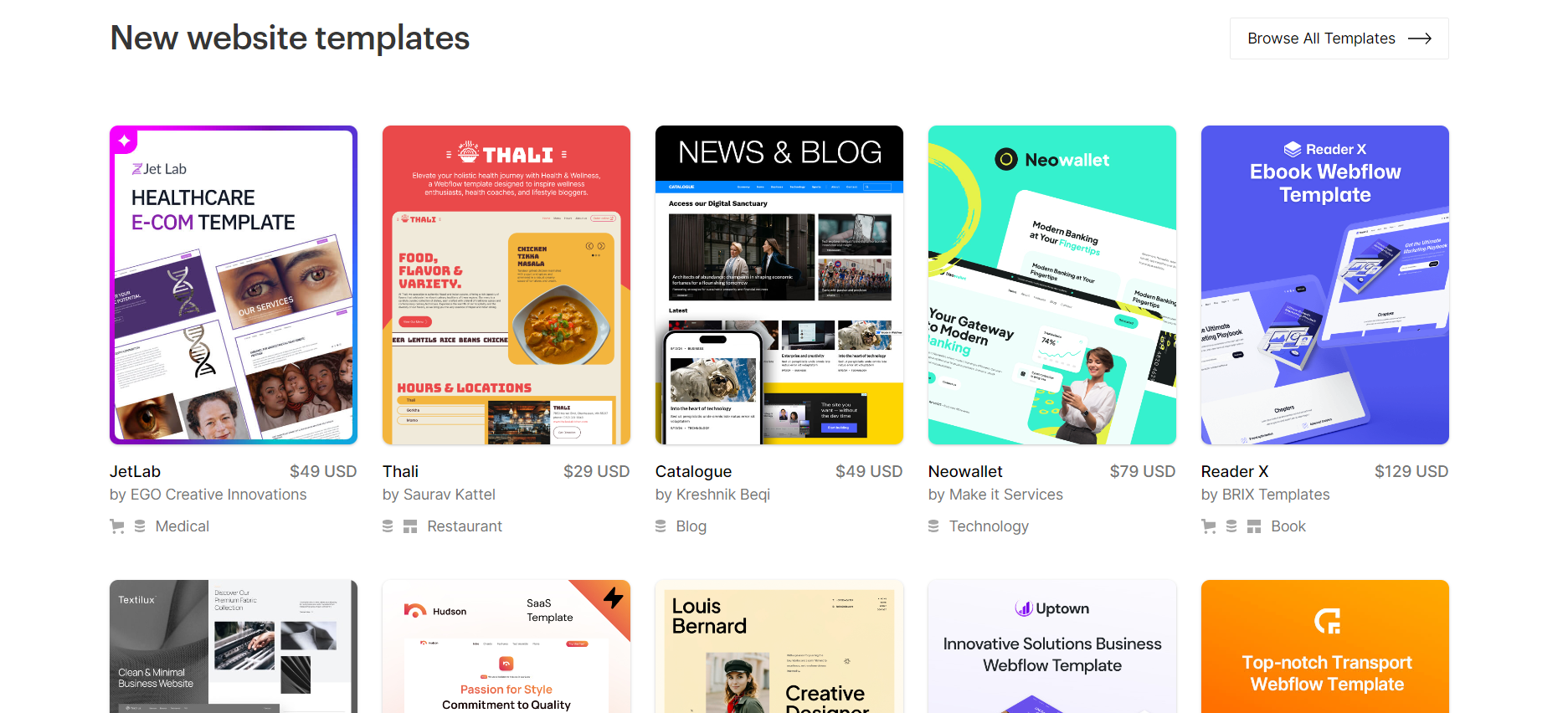
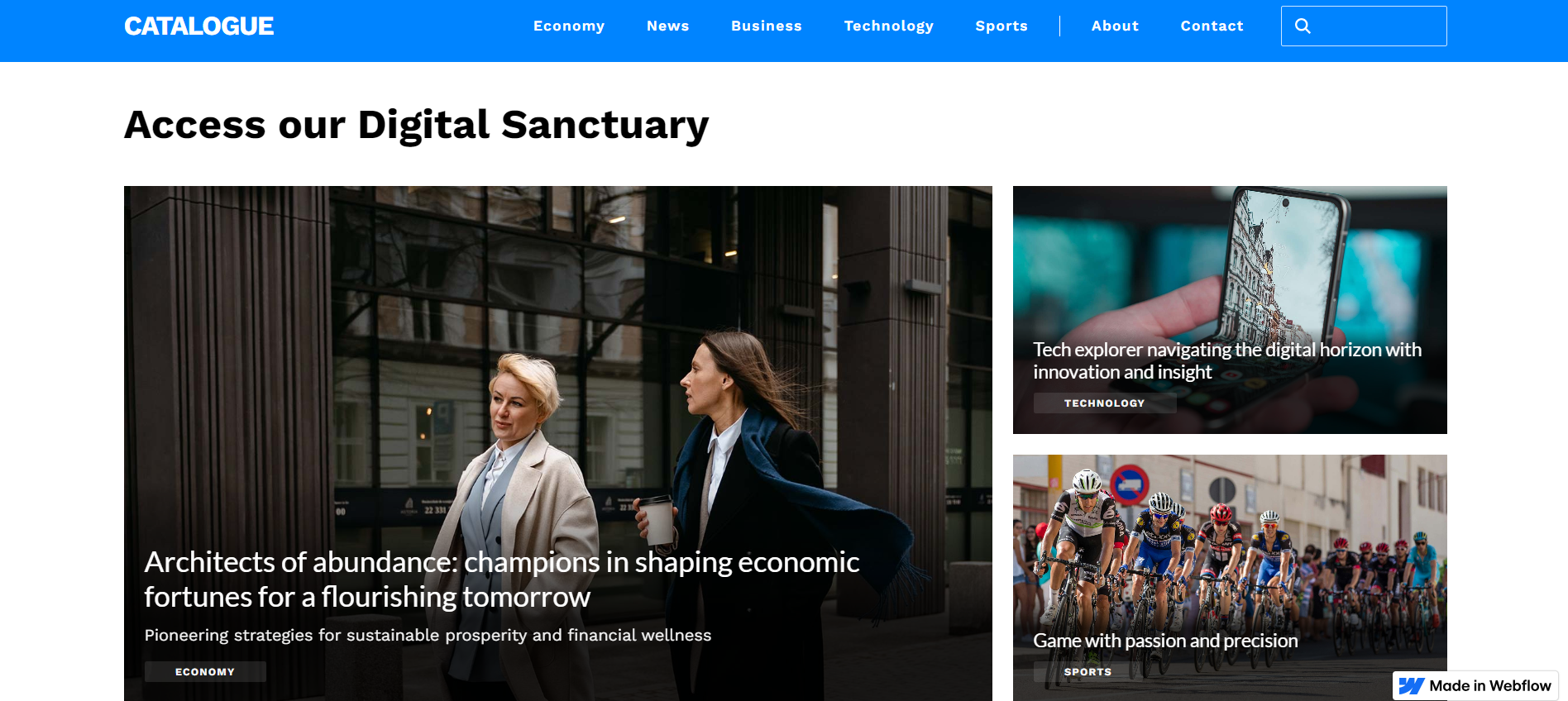
Compared to Webflow, SubHub website builder offers a variety of customizable membership website templates designed to cater to different needs and themes, including fitness, yoga, relationship, ministry, learning, craft, wellness, business, and modern living, among others. There are 14 specifically themed templates available, each designed to help users jump-start the design of their membership website homepages. These templates are fully customizable, allowing users to modify layouts, add or remove sections, and tailor content to fit their brand, ensuring flexibility in the design process.
Get a head start on website creation with AI
Create a custom website tailored to your business needs 10X faster with 10Web AI Website Builder!
Ease of use
Ease of useReflects the platform’s overall user-friendliness.Score
Components:
- Learning curve (40%): Quickness and ease of getting started.
- Interface design (30%): Simplicity and intuitiveness of layout.
- User guidance (20%): Quality of tutorials and support.
- Flexibility (10%): Adaptability to various user skills.
 7.5
7.5
 7.7
7.7
🏆 Winner: SubHub
. With a score of 7.7, SubHub slightly edges out Webflow, which scored 7.5. SubHub is designed specifically for building and managing membership sites, offering a user-friendly platform with a focus on customer support. Webflow, on the other hand, is more suitable for design-focused users and offers a visually intuitive interface, but with a steeper learning curve for beginners.
Learning Resources
🏆 Winner: Webflow
. Webflow offers a comprehensive set of learning resources, including Webflow University, a YouTube Channel, and a thriving community across multiple platforms. SubHub also offers a range of learning resources, including video guides and tutorials, but lacks a large community of users.
For ecommerce
EcommerceMeasures the platform’s effectiveness in supporting online business activities.Score Components:
- Ecommerce themes and templates (20%): Variety and design of templates.
- Product management (25%): Ease of managing and organizing products.
- Payment options (25%): Variety and convenience of payment methods.
- Ecommerce features (20%): Features for managing an ecommerce store.
- Integration (10%): Compatibility with external e-commerce tools and services.
 8.5
8.5
 5.9
5.9
Webflow and SubHub both offer ecommerce capabilities, but they cater to different needs and audiences. Webflow is a robust platform for creating online stores, offering comprehensive ecommerce features such as easy store creation without coding, extensive customization options, product management with variations, inventory tracking, integration with major payment gateways, automated shipping calculations, tax configuration, and marketing tools like abandoned cart recovery and email marketing. On the other hand, SubHub is designed specifically for creating and managing membership sites, offering a range of tools tailored for content creators and entrepreneurs who aim to build a community and monetize their content.

|

|
|
|---|---|---|
|
Ecommerce themes and templates |
7.5 |
3.0 |
|
Product page customization |
8.3 |
6.5 |
|
Payment processing and commissions |
7.8 |
7.0 |
|
POS capabilities |
6.5 |
0.0 |
|
Payment gateways |
8.0 |
6.0 |
|
Product numbers |
7.0 |
5.0 |
|
Additional ecommerce features |
7.9 |
4.5 |
Webflow ecommerce features:
- Checkout and Payment Processing with Stripe, PayPal, etc.
- Marketing and Promotions
- Tax and Shipping calculations
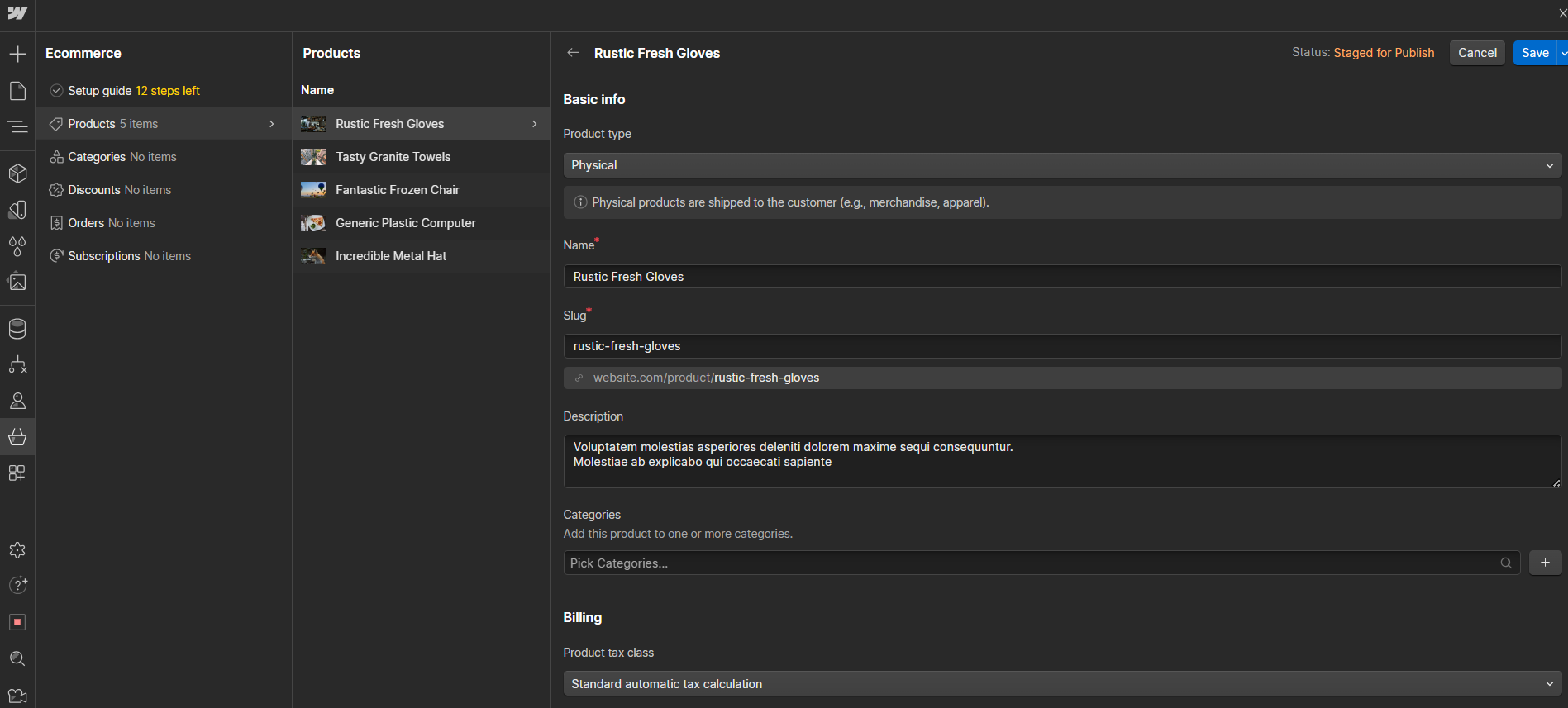
SubHub ecommerce features:
- Paypal and Stripe integration
- Physical and Digital product listings
- Pay-per view products
Ecommerce themes & templates
Webflow offers a diverse range of ecommerce themes and templates designed to cater to various types of online stores, from fashion and technology to artisan crafts and children’s products. Each template comes equipped with built-in ecommerce functionality, allowing you to easily add products and manage your store without the need for coding. SubHub, on the other hand, does not have ecommerce specific templates.
Product page customization
Webflow offers extensive customization options for eCommerce product pages, allowing users to design and personalize their pages without coding. It provides tutorials for creating product pages from scratch, offers responsive templates for various devices, and allows users to add custom code and dynamic content using Webflow’s CMS for maximum customization flexibility. SubHub offers a range of product page customization options, allowing for the addition of physical items, digital downloads, and pay-per-view content. Features include the ability to manage product variants, upload images, and set visibility preferences. Users can also implement SEO strategies through meta tags and manage tax settings. Additional functionalities include member-specific discounts, image carousels, and individualized shipping costs.
Payment processing
Webflow provides a flexible and secure platform for payment processing and ecommerce through integrations with leading payment gateways like Stripe and PayPal. This allows users to accept a wide range of payments, including credit card transactions directly from their websites. Given the versatility of Stripe and PayPal, businesses can manage online sales efficiently, and these integrations likely support various transaction types, potentially including POS transactions for physical sales environments. SubHub supports two main payment gateways: Stripe and PayPal. These integrations allow for secure payment processing for subscriptions and store items using debit or credit cards. The platform itself does not charge commissions on transactions.
Website Editors
Website EditorsEvaluates the platforms’ website building and editing capabilities.Score Components:
- Customization tools (40%): Range and power of editing features.
- Editor usability (30%): User experience within the editor.
- Design flexibility (20%): Freedom in layout and design changes.
- Update and maintenance ease (10%): Simplicity of updating and maintaining the site.
 9.0
9.0
 6.9
6.9
🏆
Winner: Webflow
. With a score of 9.0, Webflow’s editor is praised for its intuitive visual interface that simplifies the process of designing and editing responsive websites without requiring deep technical knowledge. It offers a perfect blend of ease of use for beginners and the flexibility for more advanced users, enabling significant cost savings by allowing users to customize and manage their sites without hiring professionals.
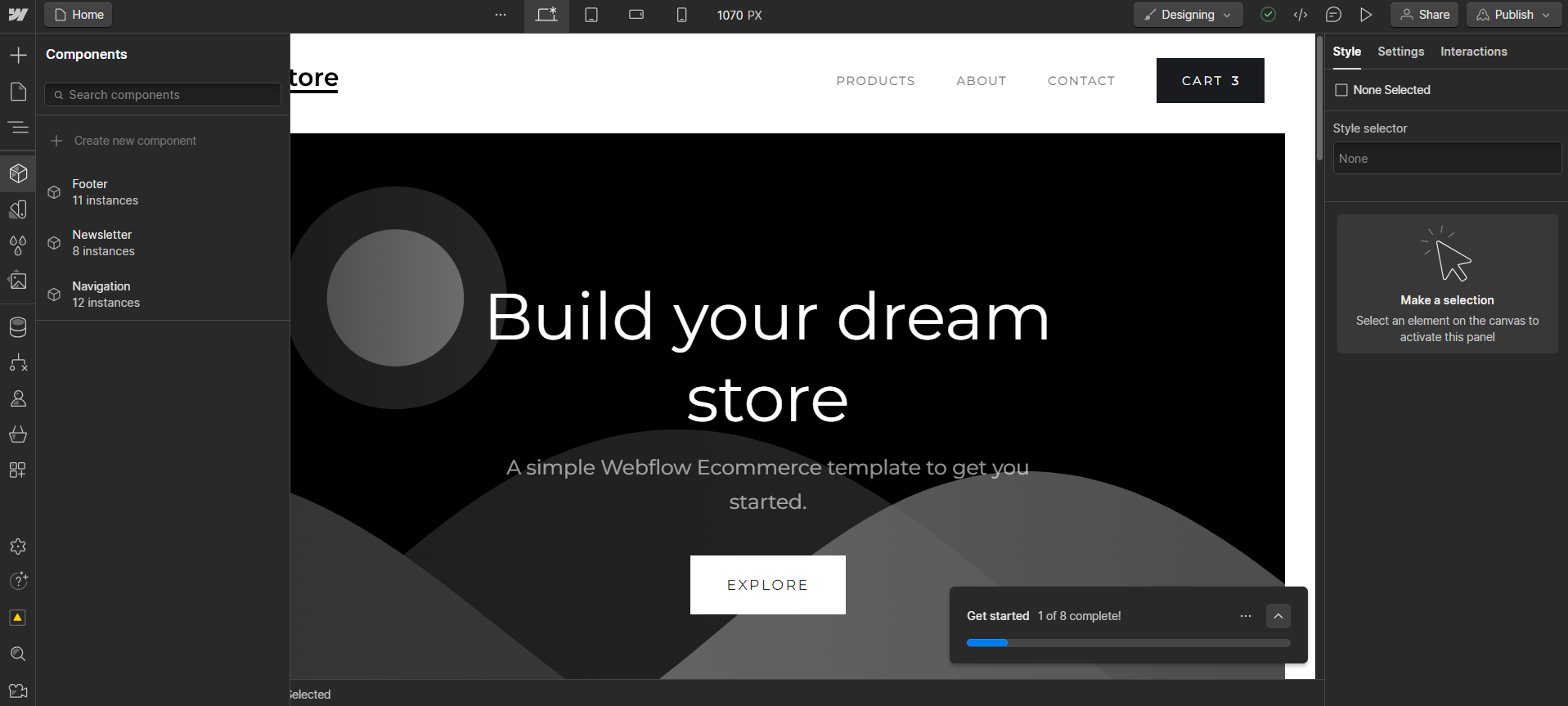
SubHub’s editor, scoring 6.9, is user-friendly, especially for beginners, with its intuitive design and drag-and-drop functionality simplifying website creation. Ready-made templates further assist users in quickly setting up their sites without needing advanced technical knowledge. However, certain tasks, such as updating DNS records, might necessitate support from SubHub customer service, indicating a potential area of difficulty for some users.
Mobile editor/app
 7.0
7.0
 4.0
4.0
🏆
Winner: Webflow
. Both Webflow and SubHub lack a dedicated mobile editor app. However, Webflow has a third-party app called EditFlow, created by a community member for Webflow users, which is currently available for iOS. This app allows users to manage their Webflow websites on the go, providing a certain level of convenience despite not being an official Webflow product.
On the other hand, SubHub does not have a dedicated mobile editor app. Users can manage some content on their website using the mobile browser version, but it’s not possible to change the layout and design of the website on mobile. This limitation can be a significant drawback for users who prefer to manage their websites on mobile devices.
In summary, while neither platform offers a perfect solution for mobile editing, Webflow comes out ahead due to the availability of the third-party EditFlow app.
Product testing options
Product Testing OptionsAssesses the options for trying out platform features before commitment.Score Components:
- Trial quality (40%): Extent and usefulness of the trial or free version.
- Feature accessibility (30%): How many features are available to test.
- Trial duration (20%): Length of the trial period.
- Ease of transition (10%): Smoothness of moving from trial to paid plans.
 6.3
6.3
 7.0
7.0
Overall Result
:
SubHub Wins
. SubHub scores 7.0, slightly higher than Webflow’s 6.3 in product testing options. SubHub offers a 14-day free trial and allows users to test premium features during this period. It also provides a 7-day money-back guarantee. On the other hand, Webflow offers a free version with basic features but does not provide a trial version or a money-back guarantee.

|

|
|
|---|---|---|
|
Free Plan |
Yes |
No |
|
Trial Duration |
No |
14 days |
|
Testing Premium Features |
Basic features with free plan |
During the free trial |
|
Money Back Guarantee |
No |
7 days |
Price
PriceLooks at the cost-effectiveness and value for money of each platform.Score Components:
- Plan value (40%): What each pricing tier offers.
- Transparency and clarity (30%): Clearness of pricing structures.
- Flexibility of plans (20%): Range of options to suit different budgets.
- Hidden costs (10%): Additional expenses not included in the plan.
 8.0
8.0
 6.8
6.8
Webflow offers a wider range of pricing options, including a free plan and custom pricing for enterprise solutions. SubHub, on the other hand, has three straightforward pricing tiers.

|

|
|
|---|---|---|
|
Free |
Starter (Free): Limited features for new sites, including 2 static pages and 50 form submissions lifetime. |
No offering at this amount. |
|
$10-$20 |
Basic ($18/month): Suitable for simple sites with a custom domain, including basic SEO controls and 500 monthly form submissions. And 100 pages. Value for price: 6.5 |
No offering at this amount. |
|
$20-$30 |
CMS ($29/month): For content-driven sites with 2,000 CMS items, 1,000 monthly form submissions, and full API access. And 150 website pages. Value for price: 7.5 |
No offering at this amount. |
|
$40-$45 |
Standard ($42/month): For new businesses with up to 500 ecommerce items, includes basic ecommerce features, and 2% transaction fee Value for price: 8.5 |
No offering at this amount. |
|
$45-$50 |
Business ($49/month): High traffic capacity, advanced features like site search, and up to 10 content editors. Value for price: 8.0 |
Starter ($47/month): Up to 500 members, 5 GB storage, secure payment processing, course builder, 5 landing pages, e-commerce. Value for price: 6.5 |
|
$80-$100 |
Plus ($84/month): Higher volume businesses with 0% transaction fees, up to 5,000 ecommerce items, and advanced features. Value for price: 9.0 |
Pro ($97/month): Up to 2000 members, 50 GB storage, removes SubHub branding, 15 landing pages, along with Starter features. Value for price: 7.5 |
|
$100+ |
Advanced ($235/month): Scalable solution for large online stores with up to 15,000 ecommerce items and the highest caps and 0% transaction fees. Value for price: 9.5 |
Premium ($147/month): Unlimited members, 200 GB storage, email white labelling, 30 landing pages, plus all Pro features. Value for Price: 8.5 |
location. As a result in rare cases the prices displayed here can differ from the ones you see on their
websites.
Hosting quality
Hosting
qualityExamines the reliability and performance of the hosting solutions.Score Components:
- Uptime (40%): Consistency and reliability of website availability.
- Speed (30%): Loading times and performance.
- Bandwidth and storage (20%): Sufficiency of resources provided.
- Data centers (10%): Quality and distribution of hosting infrastructure.
 8.9
8.9
 5.5
5.5
Winner: Webflow
. Webflow offers managed hosting included in all of their plans, with a 99.99% uptime and a guarantee for the Enterprise plan. They leverage a globally distributed network of data centers from Amazon Web Services (AWS) and Fastly. SubHub also offers managed cloud hosting, but does not provide uptime statistics or guarantees, and does not disclose the locations of its data centers. This lack of transparency and guarantee gives Webflow the edge in this category.

|

|
|
|---|---|---|
|
Do they offer hosting? |
Yes, included in all paid plans |
Yes, included in all paid plans |
|
Data Centers: |
Webflow doesn’t actually have its own data centers. Instead, it relies on a globally distributed network of data centers from Amazon Web Services (AWS) and Fastly |
Subhub does not disclose the locations of its data centers |
|
Type of hosting: |
Managed Hosting |
Managed Cloud Hosting |
|
Uptime: |
99.99% |
Subhub does not provide uptime statistics or guarantees |
|
Uptime Guarantee: |
Only Enterprise plan, 99.99% |
No |
Website Speed Optimization
Website Speed OptimizationEvaluates optimization of website loading timesScore Components:
- PageSpeed Score (30%): Google’s score indicating performance optimization.
- Loading Time (30%): The average time until a website is fully interactive.
- Mobile Optimization (15%): Optimization effectiveness for mobile devices.
- Resource Optimization (15%): Optimizing images, scripts, and other heavy resources.
- CDN Usage (10%): Use of CDN to enhance speed across geolocations.
 8.1
8.1
 5.6
5.6
🏆 Winner: Webflow
Both Webflow and SubHub have strategies for website speed optimization, but Webflow’s comprehensive approach and higher website speed optimization score give it the edge.

|

|
|
|---|---|---|
|
Focus |
Custom Cache Settings, Custom Element Lazy Loading, Automatic Minification, Responsive templates, CDN |
Image Optimization, Caching, Mobile Optimized design |
|
Performance Tools |
Google Lighthouse, PageSpeed Insights |
Google PageSpeed Insights |
|
Key Strategies |
Custom Cache Settings, Custom Element Lazy Loading, Automatic Minification, Responsive templates, CDN |
Image Optimization, Caching, Mobile Optimized design |
|
Load Times |
Below 2 seconds average |
Varies depending on optimization and website complexity |
|
Page Speed Scores Range |
77.2/100 |
Varies depending on optimization and website complexity |
|
Core Web Vitals Improvement |
Improving components’ usability, and emphasis on LCP, FID and CLS |
No information provided |
Webflow’s approach to website speed optimization includes custom cache settings, custom element lazy loading, automatic minification, responsive templates, and a content delivery network (CDN). These strategies, combined with an average load time of below 2 seconds and a PageSpeed score of 77.2/100, make Webflow a strong contender in terms of website speed. Webflow also places emphasis on improving the usability of components and the Core Web Vitals LCP, FID, and CLS.
SubHub’s strategies for website speed optimization include image optimization, caching, and mobile-optimized design. However, the load times and PageSpeed scores vary depending on the optimization and complexity of the website. SubHub does not provide any information on their Core Web Vitals improvements.
Get a head start on website creation with AI
Create a custom website tailored to your business needs 10X faster with 10Web AI Website Builder!
Plugins and integrations
Plugins and integrationsMeasures the range and effectiveness of additional plugins and integrations.Score Components:
- Variety of options (40%): Range of available add-ons.
- Integration smoothness (30%): Ease of integrating plugins into the site.
- Quality of plugins (20%): Functionality and reliability of the options.
- Custom integration capabilities (10%): Support for custom or third-party integrations.
 5.5
5.5
 5.7
5.7
🏆 Winner: SubHub.
SubHub scores 5.7, slightly higher than Webflow’s 5.5. SubHub’s focus on simplicity and integrated functionalities for building membership-based websites gives it an edge. However, Webflow offers a diverse range of integrations across various functions, which might be more appealing to users looking for a wider range of functionalities.
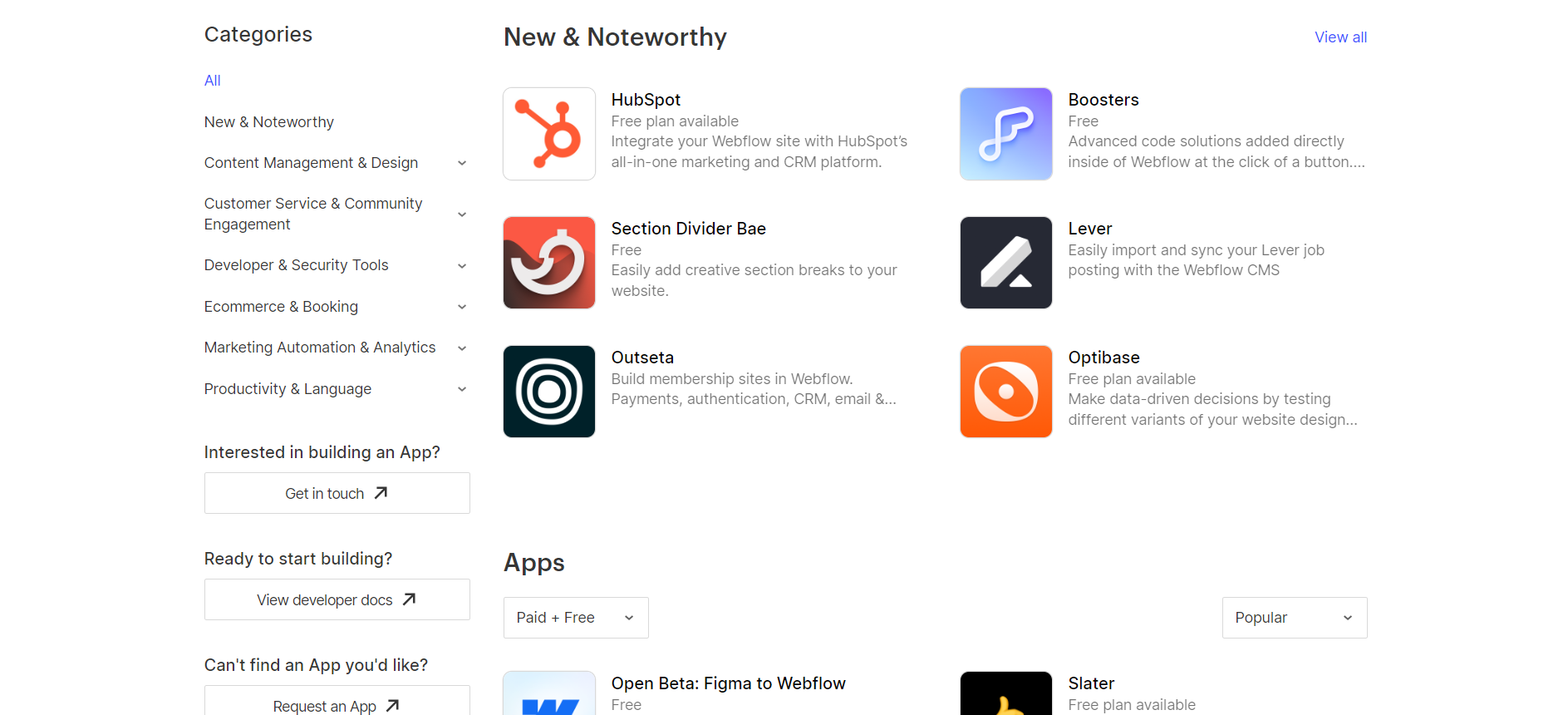
Marketing Features
Design FunctionalitiesRepresents how well each platform allows for creative design and customization of websites.Score Components:
- Template Variety (30%): Range and quality of design templates.
- Customization (30%): Flexibility and options for design alterations.
- User Interface (20%): Ease and intuitiveness of the design process.
- Responsiveness (10%): Adaptability to different devices and screen sizes.
- Innovation (10%): Unique design features and tools.
 7.8
7.8
 5.7
5.7
🏆
Overall Winner: Webflow
. Webflow stands out for its comprehensive marketing tools, including SEO, email marketing, blogging, social media integration, analytics and reporting, and ads and promotions. SubHub, while strong in SEO and email marketing, lacks social media integration.

|

|
|
|---|---|---|
|
SEO Tools |
|
|
|
Email Marketing |
|
|
|
Blogging |
|
|
|
Social Media Integration |
Simplifies content sharing and audience engagement on major social platforms |
X |
|
Analytics and Reporting |
Integrates with Google Analytics for comprehensive web traffic and behavior analysis |
Integrates with Google Analytics, including support for Google Analytics 4 (GA4) |
|
Ads and Promotions |
Supports ad and promotion management through integration with platforms like Google Optimize |
Offers promotional codes and coupon codes for specific deals on subscriptions, courses, and store purchases |
Customer Support
Customer supportEvaluates the quality and availability of support options.Score Components:
- Response time (40%): Speed of support responses.
- Support quality (30%): Effectiveness and helpfulness of the support.
- Availability (20%): Range of support channels (phone, chat, email).
- Resource richness (10%): Quality of self-help and educational materials.
 8.3
8.3
 6.3
6.3
🏆 Winner: Webflow
. Comparing Webflow vs SubHub, Webflow takes the lead in this category with its 24/7 customer support through live chat, email, and a community forum. Users appreciate the extensive documentation and video tutorials that Webflow offers, which help in navigating the platform and resolving issues efficiently. The dedicated Customer Success Manager for enterprise clients further enhances the support experience.
SubHub, on the other hand, provides customer support primarily through email and a support portal. While it offers an FAQ section for quick answers, it lacks the comprehensive support channels and enterprise-level support that Webflow provides. This makes Webflow a more robust option for users seeking reliable and extensive customer support.
Security
SecurityLooks at the platforms’ security measures and data protection.Score Components:
- Data protection (40%): Safeguards for user and customer data.
- SSL and encryption (30%): Implementation of secure connections.
- Compliance (20%): Adherence to industry security standards.
- Regular updates (10%): Frequency of security updates and patches.
 7.8
7.8
 4.0
4.0
🏆
Winner: Webflow
. Webflow takes the lead in security with a score of 7.8, compared to SubHub’s 4.0. Webflow ensures the privacy and security of user data by implementing robust encryption techniques and strict access controls. They also regularly update their systems and conduct audits to identify and address any potential vulnerabilities. Webflow employs several measures to protect user data and information, including SSL encryption, regular security audits, and strong password requirements for user accounts.
On the other hand, SubHub’s privacy policy outlines their approach to collecting, using, and protecting user personal data, emphasizing compliance with GDPR and CCPA regulations. However, SubHub does not disclose any information about website security measures the platform provides, which might be a concern for some users.
AI Capabilities
AI capabilitiesMeasures the effectiveness of AI-driven features and tools.Score Components:
- Automation efficiency (40%): Impact of AI on streamlining processes.
- Personalization (30%): AI-driven customization for users or customers.
- AI-Assisted design (20%): Role of AI in website design and functionality.
- Data analysis (10%): Use of AI in interpreting user data and analytics.
 8.3
8.3
 0
0

|

|
|
|---|---|---|
|
AI Builder |
Webflow has announced plans to introduce AI features |
|
|
AI Ecommerce features |
|
|
|
AI Content Generation |
Webflow may introduce AI content generation in the future |
|
|
Additional AI features |
Webflow plans to introduce AI-powered content management |
|
🏆 Winner: Webflow
. Although Webflow does not currently have AI capabilities, they have announced plans to introduce AI features in the future. These features include an AI copilot for design, AI-customized templates, and AI-powered content management. On the other hand, SubHub does not have any AI capabilities.
User Management
User ManagementAssesses the platforms’ capabilities in managing user roles, permissions, and accessibility.Score Components:
- Role Customization (40%): Flexibility in creating and defining user roles and
permissions. - Ease of Management (30%): User interface and tools for managing users.
- Access Control (20%): Effectiveness of access control measures for different user
levels. - Scalability (10%): Ability to manage a growing number of users efficiently.
 8.3
8.3
 5.2
5.2
🏆 Winner: Webflow
. Webflow and SubHub offer different approaches to user management.
- Webflow’s user management is more flexible, with the number of users who can edit a website and their access levels varying by plan. Core, Growth, and Enterprise plans offer unlimited editors, while others limit content editors to 3 or 10 per site. Access levels include Designer for full access and Editor for content editing. Workspace roles like Admin, Designer, and Editor ensure collaboration and security through features like the Site Activity Log and role-based permissions.
- SubHub allows multiple user accounts, however the platform does not specify how many accounts are supported.
Webflow User Roles and Access Levels:
| Role | Description | Access Highlights |
|---|---|---|
| Workspace Owner | Full control over Workspace settings and member management. | Edit settings, manage billing, access/edit all sites, invite/remove members, manage permissions. |
| Workspace Admin | Similar to the owner with some restrictions. | Edit settings, manage billing, access/edit all sites, invite/remove members (except owner), manage permissions. |
| Workspace Member | Limited control focused on site interaction. | Download invoices, access/edit sites, invite members. |
| Workspace Guest | Temporary collaborators with limited access. | Access/edit sites. |
| Workspace Commenter | Limited to commenting for feedback on sites. | Create/view/resolve comments, preview sites. |
| Site Admin | Full control at the site level. | Manage permissions, delete/transfer sites, billing management, design and publish changes. |
| Can Design | Design capabilities with some restrictions on publishing. | Design in Designer, create/modify classes and components, publish changes with permission. |
| Can Design (Limited) | Restricted design capabilities for Enterprise customers. | Create new classes, modify created classes, limited publishing capabilities. |
| Can Edit | Content editing without full design privileges. | Edit text/links/images, manage assets, publish Collection items and Ecommerce products. |
| Can Comment (Site Level) | Commenting for feedback at the site level. | Create/view/resolve comments, preview sites. |
SubHub User Roles and Access Levels:
| Role | Description | Access Highlights |
|---|---|---|
| Administrator | Full access to the platform except for Homepage and Course Editor. | Can manage all aspects of the platform, including content, store, and member management. |
| Content Management | Focuses on managing and organizing content within the platform. | Can access and manage content-related features but does not have access to Homepage or Course Editor. |
| Store (access only) | Specializes in handling the platform’s store features. | Limited to store management functions; no access to Homepage, Course Editor, or member management. |
| Member Manager (access only) | Oversees member accounts, roles, and subscriptions. | Can manage members and their subscriptions but cannot access Homepage, Course Editor, or store management. |
| *Origin Admin Email | The initial administrator with the highest level of access, including Homepage and Course Editor. | Exclusive access to Homepage and Course Editor, on top of what the Administrator role provides. |
Additional Features

|

|
|
|---|---|---|
|
SSL Certificate |
|
|
|
Custom Domain |
|
|
|
Free Custom Domain Included |
|
|
|
International Domains |
|
|
|
Mobile Responsive |
|
|
|
Page Speed |
|
|
|
Website Builder Mobile App |
|
|
|
Convert a Website To An App |
|
|
|
Website Analytics |
|
|
|
Multilingual Sites |
|
|
|
Multiple Users |
|
|
User Feedback
Webflow receives high praise for its user-friendly interface, eliminating the need for coding while offering extensive design flexibility. Users appreciate its scalability, cost-effectiveness, and seamless integration of essential features like forms and CMS. However, some users note a slight learning curve and occasional limitations, particularly in ecommerce functionalities and content management. Overall, Webflow proves to be a powerful tool for building and managing websites, offering robust features for both beginners and experienced developers, albeit with some room for improvement in certain areas like collaborative editing and content management.
User feedback on SubHub presents a mix of positive and negative experiences, emphasizing the platform’s feature-rich environment and customizable templates. Users appreciate the flexibility and the quality of customer service, highlighting the platform’s continual updates and support as key benefits. However, some users express dissatisfaction with aspects such as the platform’s interface, lack of community features, and service fees for ticket resale. Concerns were also raised about the custom design service and mobile-friendly solutions taking longer than expected.
The making of this blog
We followed a clear, step-by-step process to write and research this article.
FAQ
Which platform is better for building a membership site, Webflow or SubHub?
Can I use Webflow for ecommerce?
Is SubHub good for selling products?
Which platform offers better design and customization options?
How do Webflow and SubHub compare in terms of ease of use?
What are the main differences in pricing between Webflow and SubHub?
Which platform has better customer support?
Can I manage a blog with SubHub?
Is Webflow suitable for beginners?
What security measures do Webflow and SubHub offer?










